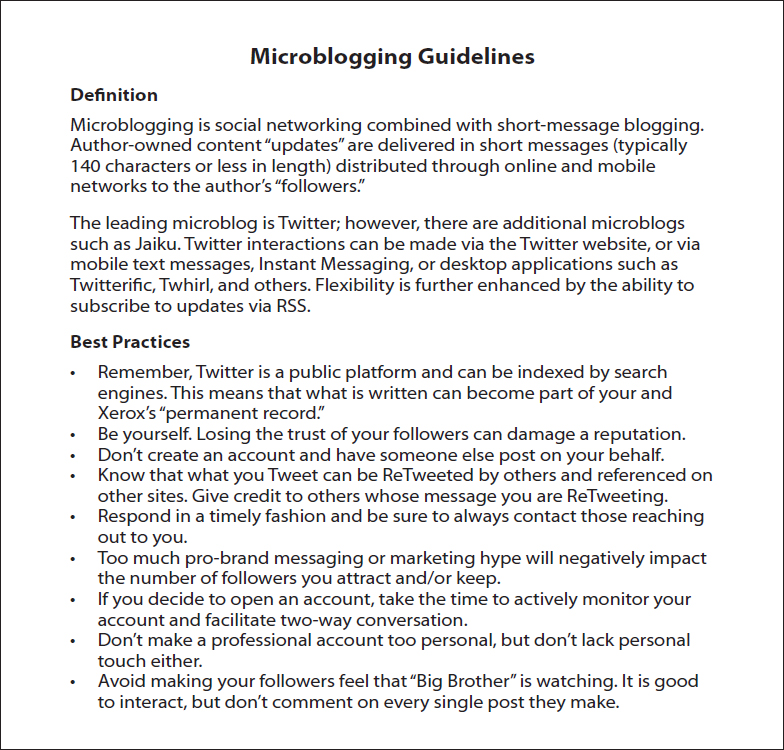Writing Microblogs
Printed Page 377-380
Writing Microblogs
As discussed earlier in this chapter, microblog posts are different from letters, memos, and email in that they are often extremely brief and quite informal in tone. Usually, you do not revise microblog posts extensively. You just proofread and send them.
However, the fact that microblog posts are fast and informal does not mean that anything goes. When you write microblog posts, you are creating communication that will be archived and that will reflect on you and your organization. In addition, anything you write is subject to the same laws and regulations that pertain to all other kinds of documents. Many of the guidelines for following netiquette apply to microblog posts as well as email. Take care, especially, not to flame. Become familiar with your microblog’s privacy settings, and be aware of which groups of readers may view and share your posts.
The best way to understand your responsibilities when you write a microblog post at work is to study your organization’s guidelines. Sometimes, these guidelines are part of the organization’s guidelines for all business practices or all digital communication. Sometimes, they are treated separately. Figure 14.14 shows one company’s microblogging guidelines.

Representing Your Organization on a Microblog

If you use a microblog at work to communicate with people outside your own organization, such as vendors and customers, you want to use it in such a way that people are encouraged to like, respect, and trust you. These ten suggestions can help.
- Decide on your audience and your purpose. Are you connecting with clients, providing customer service, helping people understand your company’s goals and vision? You might want to have different accounts if you have several different audiences and purposes.
- Learn the technology. Know how to use hashtags, how to mention other users in your tweets, how to reply publicly and privately, how to integrate images and videos, and how to cross-post to your other social media accounts should you need to.
- Learn the culture of the community. Listen and learn before you post. Most communities have a distinct culture, which influences how and when people post, link, and reply. For instance, in some communities, people stick close to the technical topic; in others, they roam more freely and include personal comments.
- Share, don’t sell. Post about incidents and developments that reinforce your organization’s core principles, such as environmental awareness or making technology available around the world. Talk about leadership, teamwork, and cooperation. Don’t try to sell products.
- Help educate readers and solve their problems. Regardless of whether you’re responding to individual questions and complaints or helping people understand your company’s culture or goals, focus on helping people learn and solve problems.
- Sound like a person. Use an informal tone. Readers are especially pleased when high-ranking employees show their human side, such as when the Zappos CEO posted, “Dropped my laptop on floor this morning. I usually drop my phone, so good to know I’m moving on to bigger and better things” (Hall, 2009).
- Apologize when you make a mistake. Pepsi recently ran a marketing campaign about a one-calorie product in which the cartoon calorie was so lonely it was considering suicide. After someone complained about the ad’s insensitivity, a Pepsi representative tweeted her (and the rest of the world) to apologize. Using his own name, he agreed with her that the ad was inappropriate and said he had taken it down (Stibell, 2011).
- Link generously. When you want to talk about something you’ve learned online, don’t paraphrase. Rather, link back to the original source. Use a URL shortener such as Bitly or TinyURL so that the link won’t take up too many of your 140 characters.
- Get your facts right. Like anything online, your post is permanent. Double-check your facts before you post. Otherwise, you could embarrass yourself and erode people’s trust in your professionalism.
- Edit and proofread before you post. You should be informal, but you shouldn’t be sloppy. It sends the wrong message.